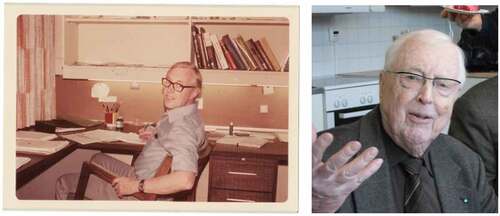This issue of Solvent Extraction and Ion Exchange is dedicated to the memory of Professor Jan Rydberg. The authors are either direct co-workers or students of Jan or are connected through scientific pedigree separated by one or more generations.
Although Jan officially retired in 1988, his work in the fields of solvent extraction and nuclear chemistry is well known to most of the readers of the journal even today. However, he continued to be a mentor and inspiration and supporting colleagues around the world to the day before his demise 91 years old in 2017. His curious and sharp mind is well illustrated in the photos above where he can be seen as a hopeful, dedicated student and as an elderly man studying the world around him with vivid interest. This interest was not only scientific but also societal and social where he had considerable talent. We fondly recall one such event taking place not long after Jan received the Hansen award, which was presented to him during the ISEC conference in Tucson 2008. Jan was curious whether or not the Hansen medal was solid gold which led him to weigh the medal, estimate the volume by submerging it in water in a graduated vessel and calculate the density. Whether or not Jan found that the medal was solid gold or not, we unfortunately cannot recall, but this was the type of curiosity and need to understand the world around him that we would associate with Jan.
We will try to give a brief description of Jan not in terms of publications or performance indicators, but rather by showing his foresight as a scientist and ability as a mentor. As an example of the former, most nuclear chemists in the world knows of the famous Choppin – Rydberg textbook in nuclear chemistry that was first published in 1980. What most people do not know was that there was a version written in Swedish with, in principle, the same texts (some sections missing) published in 1964. Jan was always somewhat ahead of his time. Already in the 1950s, he was using computers to determine stability constants for chemical reactions, often using solvent extraction and associated theories to do it. What is less known was that Jan already then appreciated the role of uncertainty analysis of these methods as well as the others used at this time. It took decades for the scientific community to appreciate the importance of these confidence-based determinations which were often dismissed with claims like “I did good experiments so nothing is uncertain”, by his contemporaries.
Jan was also instrumental in the collection of state of the art solvent extraction knowledge by editing the well-known book “Solvent Extraction – Principles and Practice” in which he attracted several of the world experts in the field to write about their special expertise. Even if this may not be the most pedagogic textbook for students it is an invaluable encyclopedia for scientists active in the field and widely cited.
The integrity and mentorship skills of Jan were clearly proven when he retired. He did not try to cling to power with all his efforts. Rather, he told all of us that he was willing to help in any way he could but the contact should come from the people who are active now. This position made it very attractive to ask for his advice and involve him in the work where he shared his knowledge and ideas. It is said that nothing grows under a great tree but for Jan this is not true. He let his students grow independently as I am sure that many of the international scientists that visited his group for longer or shorter stays would testify to. Some of them have written papers in this honorary issue of SXIX.
Scientific pedigree is an interesting concept. It is said that any active scientist is not more than five generations away from a Nobel Prize winner. We who edited this issue dedicated to Jan are his scientific children of different generations. Christian Ekberg is through Jan-Olov Liljenzin (Jan’s student) a “grandchild” of Jan, and Mikael Nilsson was once Liljenzin and Ekberg’s student. However, due to Jan’s ever-present enthusiasm, both of us have had the pleasure to discuss our work and life with him on a weekly basis until in Mikael’s case, he pursued a career outside of Sweden. Christian became head of Jan’s old departments and profited from Jan’s enthusiasm, ideas and mentorship until 2017. A special case was that materials recycling which was started by Jan in the 1960s and then became an industrial endeavor was reintroduced into the group in 2007 to Jan’s great pleasure.
We are happy and proud to have been students, and friends of Jan Rydberg and with this special issue we hope to give him some of the tribute he is certainly due.

